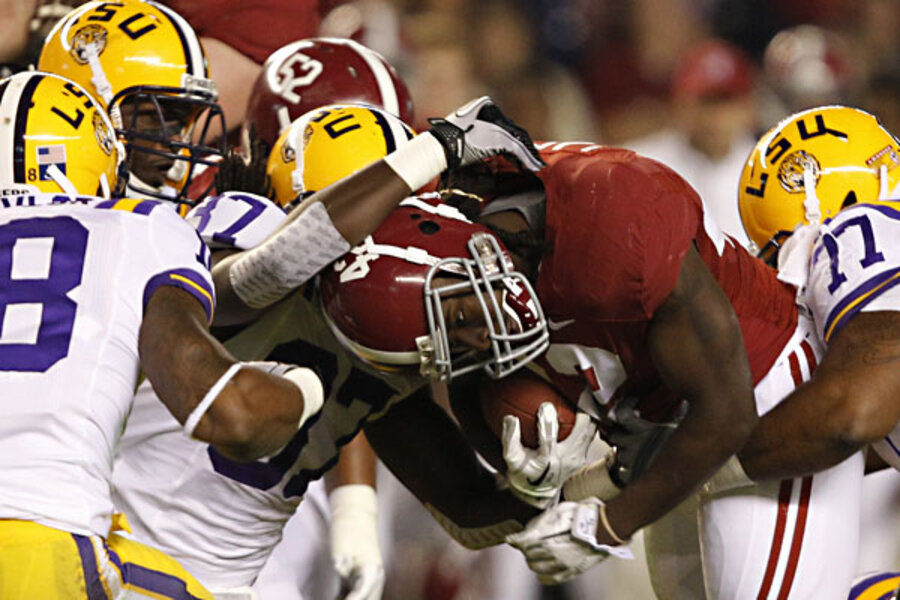BCS championship: SEC dominates all the way to the bank
Loading...
The SEC’s domination of college football has ratcheted up another notch, as it claimed yet another national title for itself Sunday night.
True, the kickoff of the 2012 Allstate BCS Championship game isn't until Jan. 9. But it doesn't matter whether the winner is undefeated and top-ranked Louisiana State University or No. 2 Alabama, whose only loss was a close one in overtime to LSU on Nov. 5. They're not only from the same conference; they're from the same division, the SEC West.
This will be the first time in the history of the 14-year-old BCS that two division rivals, having previously met in the regular season, will be playing for the title.
Alabama’s No. 2 ranking has prompted outrage among those who think that a one-loss team from another conference, specifically Big 12 Conference champion Oklahoma State, deserved a go at LSU. The Crimson Tide already had its try, after all. But in a week where both the LSU Tigers and the Oklahoma State Cowboys had to play and win their respective conference championships (and Alabama got the week off), the computers that calculate the BCS rankings held Alabama as the slightly better team, prompting the all-SEC January rematch.
The matchup guarantees the SEC its sixth national championship title in a row, and its seventh in 10 years.
That run has been a boon for fans in the college football-crazed southeastern United States, but dismal news for supporters of other NCAA conferences, who now don’t even have a team to support through which they can root against what has become the "evil empire" of college football conferences.
To add to the sting, SEC has walked away with piles of money as a result of its BCS success, helping to fuel future success.
A bid to a BCS bowl game comes with a payout, usually correlated to the prestige of that particular game. The largest – the Fiesta. Sugar, Orange, and Rose Bowls – each give payouts of $17 million per team. At the other end of the spectrum, the New Orleans Bowl, this year a matchup between the San Diego State Aztecs and the Louisiana-Lafayette Ragin’ Cajuns, will pay its teams $325,000 apiece.
The more participants in prestigious bowl games a conference has, the more money it gets. This year, the BCS National Championship game payout is slated at $21.2 million per team. If the BCS sticks to precedent and pays each team, rather than combining the share into a smaller lump sum, the SEC will walk away with more than $42 million. That’s in addition to all of the money it stands to make on merchandise, ticket sales, and additional SEC teams in other major bowl games.
The payout system isn’t always the jackpot it seems, and it tends to benefit some conferences and universities more than others. Last year, for example, the Big East Champion UConn Huskies ended up losing money on their trip to the Fiesta Bowl, despite the game’s $17 million payout. How? The smallish school had to absorb the cost of 17,000 unsold Fiesta Bowl tickets as well as the cost of transporting and housing football players, cheerleaders, and marching band members from Connecticut to Tempe, Ariz. over a busy holiday weekend. After the Big East divided up the Fiesta Bowl payout, the Huskies only received approximately $2.5 million.
None of those problems should plague the Tigers or the Crimson Tide. The national championship game is in the New Orleans Superdome this year, a short trip for both teams and their ardent fan bases (it's safe to assume that ticket sales won’t be an issue). The revenue earned will go right back into the SEC football programs, where it will be used for equipment, facilities, marketing, and recruiting. Not that the SEC is a tough sell to top high school prospects: in addition to monopolizing the National Championship game, the SEC held all three of the top spots in the BCS rankings just two weeks ago (the Arkansas Razorbacks were No. 3).
Furthermore, rumors abound of the SEC flirting with adding a number of big-time football programs to its lineup, including the Florida State Seminoles, the Texas A&M Aggies, and the Oklahoma Sooners.
Thus, as other conferences look on, the SEC becomes bigger, richer, and more difficult to beat.





